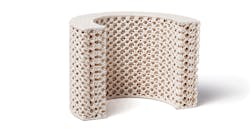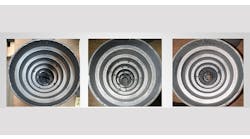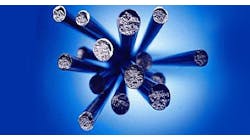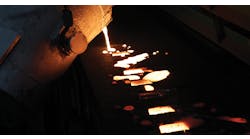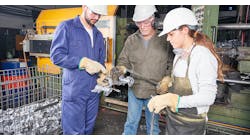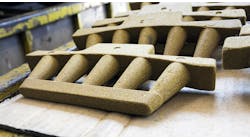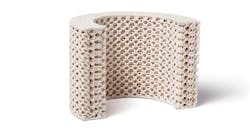Q: Why do we find seasonal variations in curing speed for our foundry‘s no-bake molding process?
A: It is not uncommon for foundries to experience variations in curing speeds in their no-bake lines as the seasons change. The most likely cause of this problem are the changes in environmental temperatures and consequently the temperature of molding sand. Temperature-related variables, which affect reaction speeds and curing times, must be considered as seasonal conditions change. It is well established that temperature has a critical role in the determination of work time and strip time (WT/ST) for the no-bake curing process.
Ideally, a foundry would maintain a constant sand temperature to ensure consistent cure times. However, it is far more practical to alter the catalyst strengths or quantities. To achieve a desired WT/ST, a balance must be struck between the temperature of the molding sand and the quantity and reactivity of the selected catalyst.
The relationship between sand temperature and no-bake resin reaction times has come to be known colloquially as “the 18 degree rule.” This rule describes an observed trend wherein as the temperature of molding sand decreases by 18 °F, the reaction time (and strip time, ST) effectively doubles.
This rule can be explained by the kinetics of the curing reactions, and what is known as the temperature-dependent rate constant. Experimentally, for a phenolic urethane binder system the rate constants generally follow a standard Arrhenius behavior within a limited temperature range.1
Alternatively, in chemical reaction kinetics this behavior could be expressed through the use of the Q10 temperature coefficient, which is a function of the rates of a reaction at two different temperatures. Generally, the former exists as the more common descriptor of chemical reaction rates as a function of temperature. Experimental modeling concerning the simple reaction of diisocyanates with diethylene glycol adipate demonstrated that Arrhenius rate constants increased by a factor of 1.5-2 every 18 °F, depending on the functionality of the diisocyanate reacted.2 This physically manifests as the aforementioned, temperature-dependent twofold increase in WT/ST observed in foundries.
It should be noted, however, that this rule is not unique to phenolic urethane resins. The same behavior and temperature dependence can be seen across all no-bake product lines (phenolic urethane, furan, and alkaline phenolic), and must be corrected for accordingly.
To accommodate for this behavior, catalyst adjustment can be used to overcome small changes in sand temperature. It is recommended that foundry operators consults their supplier to appropriately reevaluate the strength or quantity of the catalyst in use. Generally, it is recommended that a greater quantity or more-reactive catalysts be used in the colder months, while a lower quantity or less-reactive catalysts be used when the weather begins to warm.
By seasonally adjusting the catalyst used in the no-bake molding process, a foundry can mitigate the cure-speed changes seen as temperatures fluctuates to ensure adequate mold quality year-round.
Join the Conversation. Email Your Questions for ASK Chemicals Share your insights, opinions, and elaborate on the questions and the experts' answer(s). You must be logged in to the website in order to post your comments.
